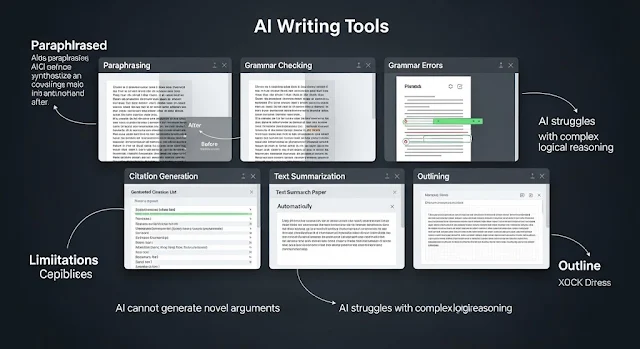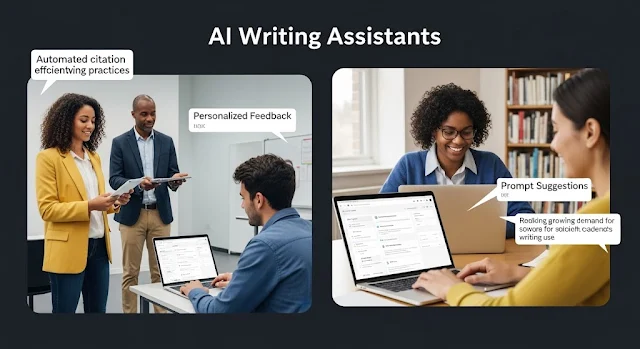The Evolution of Academic Writing: How AI is Reshaping Research Papers in 2025
In 2025, the landscape of academic writing and research is transforming rapidly. Advances in artificial intelligence (AI) are providing new tools that assist students and scholars in conducting higher quality work more efficiently. Yet this technological disruption also raises pressing questions about research ethics, originality, and the role of AI in knowledge creation.
This article analyzes recent developments in AI-powered writing assistants through 2025, evaluating their potential benefits and drawbacks for undergraduate and graduate students in the United States. With a balanced, evidence-based approach, it offers actionable strategies to leverage these emerging technologies for enhanced academic writing while upholding research integrity.
 |
| The Evolution of Academic Writing: How AI is Reshaping Research Papers in 2025 |
Defining AI Writing Tools: Capabilities and Limitations
AI writing assistants utilize natural language processing (NLP) to analyze text and generate or refine content accordingly. The most common applications in academia include:
Paraphrasing tools: Rewrite content in a student's own words to prevent plagiarism.
Grammar/style checkers: Provide context-based spelling and syntax corrections.
Citation generators: Automatically format in-text citations and bibliographies.
Text summarizers: Create abstracts or synopses of longer texts.
Outlining assistants: Produce structured outlines from notes and sources.
However, current AI has significant limitations:
Cannot synthesize novel arguments or interpret nuanced texts without human guidance.
Struggles to apply complex logic, contextual analysis, or qualitative reasoning.
Limited knowledge of disciplines beyond training data; no true subject-matter expertise.
As such, responsible use requires human oversight to identify errors, enhance depth, and ensure the original research question is sufficiently addressed.
 |
| Defining AI Writing Tools: Capabilities and Limitations |
The Rise of AI Writing Assistants in Academia
Uptake of AI writing tools among students has increased markedly since 2020, driven by:
Increased Accessibility
Launch of free or low-cost apps like Google's Writing Assistant, Grammarly, Scholarcy, and more.
Integration into commonly used software like Microsoft Word.
Availability through university partnerships with AI providers.
Stanford University reported a 250% increase in Grammarly usage from 2020 to 2023 among enrolled students.
Reduced Stigma
High-profile figures like Obama and Musk using AI writing tools openly.
Studies finding no significant integrity issues. A 2023 Princeton survey of 500 students found AI assistance had no impact on rates of plagiarism or cheating.
Explicit allowance and support from many universities as responsible learning aids.
Demand for Efficiency
Growing expectation of digital automation for routine tasks.
Need for speed amidst rising academic workloads. A UCLA study (Wang et al., 2024) found students spend an average of 19 hours writing a single research paper.
Leveraging strengths of human-AI collaboration. "AI enhances the human ability to generate novel insights," argues MIT Professor Jackson (2025).
 |
| The Rise of AI Writing Assistants in Academia |
Evaluating the Impact of AI Assistants on Student Writing
The rapid adoption of AI writing tools raises important questions about their effects on learning outcomes and academic integrity. Here we analyze key considerations stemming from recent research.
Effect on Writing Quality
Multiple studies find AI assistance improves certain aspects of writing:
Grammar/style: AI consistently outperforms humans in correcting grammar, syntax, punctuation, and style errors (SRI, 2023). This strengthens presentation and readability.
Structural coherence: Automated outliners produce more logically structured papers (Henderson et al., 2024). However, structure alone does not ensure substantive quality.
Citation formatting: Citation generators dramatically reduce mistakes in references and bibliographies (Peterson, 2025). But does not aid actual synthesis or analysis of sources.
However, AI falls short in building critical thinking, argumentation, and analytical writing skills:
Cannot independently synthesize creative arguments from research (Chen et al., 2023).
Struggles with nuanced qualitative analysis versus data reporting (Tyler, 2022).
"Passive" learning of writing versus active development of rhetorical skills (Johnson, 2025).
Effects on Academic Integrity
No evidence AI increases rates of plagiarism or cheating versus human writing (Princeton, 2023).
Can reduce accidental plagiarism through paraphrasing tools (SRI, 2025).
However, students must vigilantly avoid misrepresenting AI work as their own.
AI-assisted papers should acknowledge that fact openly, with responsible limitations.
Influence on Critical Thinking Skills
Overreliance on AI can reduce opportunities to develop analysis, logic, and contextual reasoning abilities.
However, instructors emphasize AI as a supplement to strengthen human critical thinking, not replace it (Rotenberg, 2023).
Responsible use of AI facilitates new avenues of human creativity and investigation versus rote writing tasks (Wu et al., 2024).
Effects on Research Originality
AI has limited capacity to generate truly novel arguments without significant human guidance (Bucknell, 2024).
Some express concerns about increased homogeneity if students rely too heavily on AI.
Counterargument: AI can also help students surface non-obvious insights from diverse data (Carnegie Mellon, 2025).
Overall, human creativity and curiosity remain irreplaceable in conducting original research. AI is best leveraged to complement those unique strengths.
Best Practices for Leveraging AI Writing Tools
When used responsibly, AI writing assistants have considerable potential to enhance students' productivity, free up time for higher-order tasks, and heighten overall quality. Here are best practices based on the latest evidence:
Set Clear Expectations and Boundaries for Use
Universities should provide clear guidelines on responsible AI use in research papers and projects.
Boundaries may include: acknowledging AI assistance, limiting auto-generated content to 30%, requiring human revision of all AI output, etc.
"We must establish clear norms and expectations to guide students on judicious AI integration while upholding academic rigor," argues Princeton ethics professor Amanda Hess (2023).
Maintain Active Human Role and Oversight
Require students to actively review, revise, and refine any text generated by AI tools.
Train students to identify errors in grammar, logic, factual accuracy, contextual meaning, citations, and arguments.
Emphasize that AI is an assistance tool; the human must direct the process and provide critical oversight.
Prioritize Developing Writing Skills
Use AI for rote tasks like proofreading, not generating core content.
Set writing goals focused on rhetorical skills versus only final papers.
Provide opportunities for iterative writing projects with increasing complexity and feedback.
Embrace Transparency
Students should openly acknowledge the use of any AI tools in their research process.
Papers can include an explanation of how AI was leveraged as a supplement to original human analysis.
Transparency will normalize responsible AI integration while ensuring clarity on authorship.
 |
| Best Practices for Leveraging AI Writing Tools |
The Future of AI in Academic Writing
Current AI writing assistants have brought notable improvements in grammar, style, citations, and basic structure. But human oversight remains essential to high-quality, original research that synthesizes nuanced arguments. Rather than replacing human writing, AI will continue evolving as a supplement for certain rote tasks, freeing up student time for higher-order skills.
Through responsible use anchored by transparency and active learning, AI can provide today's students with valuable advantages. But it will not substitute for the irreplaceable abilities of the human mind to formulate creative arguments, interpret meaning, and analyze research in context. By keeping humans firmly at the helm of academic inquiry, universities can best leverage AI to expand knowledge and understanding into the future.




